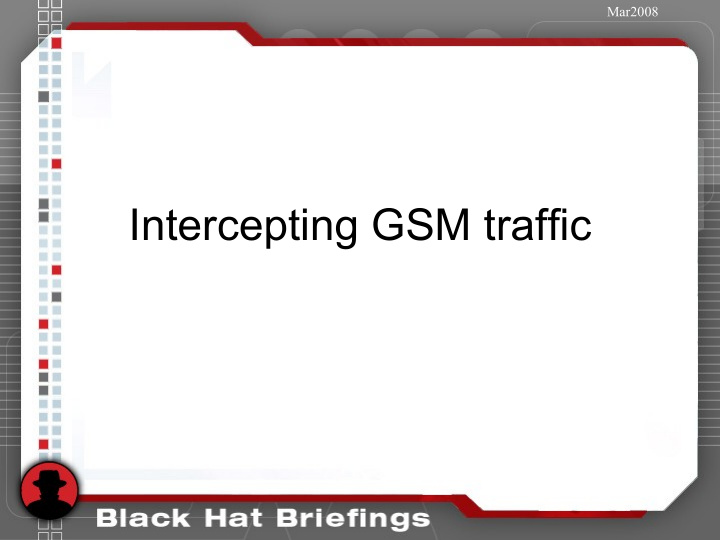



Mar2008 Intercepting GSM traffic
Mar2008 Agenda • Receiving GSM signals • Security • Cracking A5/1
Mar2008 GSM Network
Mar2008 BTS
Mar2008 Camouflage BTS
Mar2008 Summary GSM • GSM is old • GSM is big • GSM / 3G / UMTS / EDGE / WCDMA / . • Base stations all over the place
Mar2008 Receiving • Nokia 3310 / Ericsson / TSM • USRP • TI's OMAP dev kit • Commercial Interceptor
Mar2008 Example 1
Mar2008 Example 2
Mar2008 Summary Receiving • It's cheap • It's easy • It's getting easier
Mar2008 Security
Mar2008 Security
Mar2008 Security
Mar2008 Commercial Interception • Active Equipment: – $70k - $500k. Order via internet. • Passive Equipment: – $1M
Mar2008 Radio Security • A5/0, A5/2, A5/1. All broken in 1998. • Some algorithms proprietary • IMSI / Location Information clear-text • Key is artificially weakened • Key material is reused • No indication to user • Key Recovery Systems available
Mar2008 SIM Toolkit • There is a JVM on your SIM! • The Operator can install programs via OTA (== remotely, without you knowing) • Scary standard: Invisible flags, binary updates, call-control, proprietary, ....
Mar2008 Security Summary • None
Mar2008 A5/1 Cracking A8(Ki) A8(Ki) Authenticate Kc Kc A5(Kc) A5(Kc) Conversation
Mar2008 A5/1 Cracking Conversation Phone Sending to BTS Frame Frame + + A5(Kc,Frame) A5(Kc,Frame) Plain-text Plain-text
Mar2008 A5/1 Cracking • Clock in 64-bit Kc and 22-bit frame number • Clock for 100 cycles • Clock for 114 times to generate 114-bits
Mar2008 Cracking A5/1 • Other attacks are academic BS. • 3-4 Frames. Fully passive. • Combination of Rainbow Table attack and others.
Mar2008 Cracking A5/1 • 4 frames of known-plaintext • A5/1 is a stream cipher • We can derive 4 frames of keystream output
Mar2008 Sliding Window [0|1|1|0|1|0………………………....….…....….|1|0|1|1] [ 64 bit Cipherstream 0 ……….] [ 64 bit Cipherstream 1 ……......] [ 64 bit Cipherstream 2 ..……….] …………………………. [ 64 bit Cipherstream 50 ..……….]
Mar2008 Sliding Window • Total of 4 frames with 114-bits • 114 – 64 + 1 = 51 keystreams per frame • 51 x 4 frames = 204 keystreams total
Mar2008 Rainbow Table 64-bits keystream Password Lanman Hash
Mar2008 Rainbow Table • Build a table that maps 64-bits of keystream back to 64-bits of internal A5/1 state • 204 data points means we only need 1/64 th of the whole keyspace • 2 58 = 288,230,376,151,711,744 • About 120,000 times larger than the largest Lanman Rainbow Table
Mar2008 How do we do this?? • 1 PC – 550,000 A5/1's per second – 33,235 years • Currently using 68 Pico E-16 FPGAs – 72,533,333,333 A5/1's per second – 3 months • Building new hardware to speed this up
Mar2008 Hardware
Mar2008 Rainbow Table • Cheap Attack (~30 min) – 6 350GB Hard Drives (2TB) – 1 FPGA (or a botnet) • Optimal Attack (~30 sec) – 16 128GB Flash Hard Drives (2TB) – 32 FPGAs – Can speed it up with more FPGAs
Mar2008 Rainbow Table • 204 data points will give us 204 / 64 = 3 A5/1 internal states • So what do you do now?
Mar2008 Reverse Clocking • Load A5/1 internal state • Reverse clock with known keystream back to after Kc was clocked in • Will resolve to multiple possible A5/1 states
Mar2008 Reverse Clocking • Reverse all 3 A5/1 internal states • The common state will be the correct one • Use the internal state and clock forward to decrypt or encrypt any packet • Can solve linear equations to derive key • But isn't really necessary
Mar2008 Conclusions • Tables will be finished in March • Commercial version in Q2/08 • Will be scalable to whatever decryption time period is required
Mar2008 Threats & Future • GSM security has to become secure. • Data/Identity theft, Tracking • Unlawful interception • Attacks on GSM Infrastructure • Receiving and cracking GSM will become cheaper and easier
Mar2008 Thank You! • Steve – http://wiki.thc.org/gsm • David Hulton – http://www.picocomputing.com – http://www.openciphers.org • Questions?
Recommend
More recommend